In 1991, South Africa eradicated feral cats Felis catus on its sub-Antarctic Marion Island, still the largest island in the world, at 290 km², where such has been achieved. Attention then turned to Marion’s remaining introduced mammal, the House Mouse Mus musculus, with a workshop held in 1995 to consider the desirability of their eradication. In the event not much further happened on managing mice on the island for the next two decades, but increasing evidence is now emerging that the mice are a serious threat to the island's bird life.
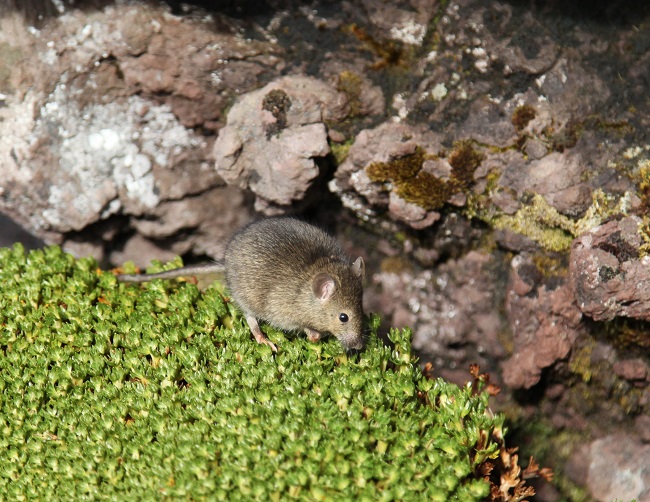
A Marion Island House Mouse, photograph by Peter Ryan
In particular, since 2003 gruesome observations of mice attacking and killing albatrosses and burrowing petrels on the island have shown that the mice are not the “benign presence” they had once been thought to be. Responding to the mouse attacks the NGO BirdLife South Africa commissioned a review of the impacts of the island’s mice, and then with logistic support from the South African Department of Environmental Affairs (DEA) to enable a site visit, a feasibility study for their eradication by island eradication expert John Parkes of Kurahaupo Consulting, New Zealand.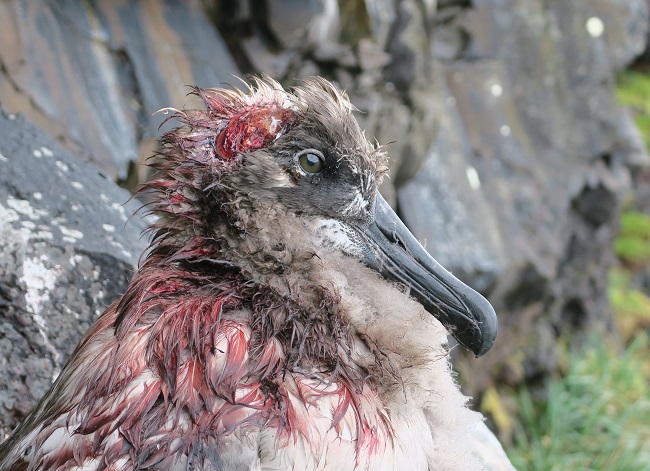
A "scalped" Light-mantled Sooty Albatross on Marion Island, photograph by Peter Ryan
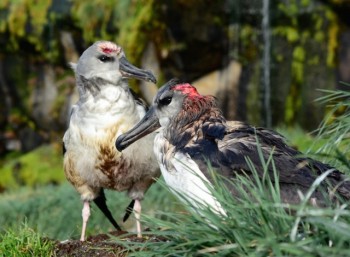
Grey-headed Albatross chicks "scalped" by House Mice at Marion, photograph by Ben Dilley
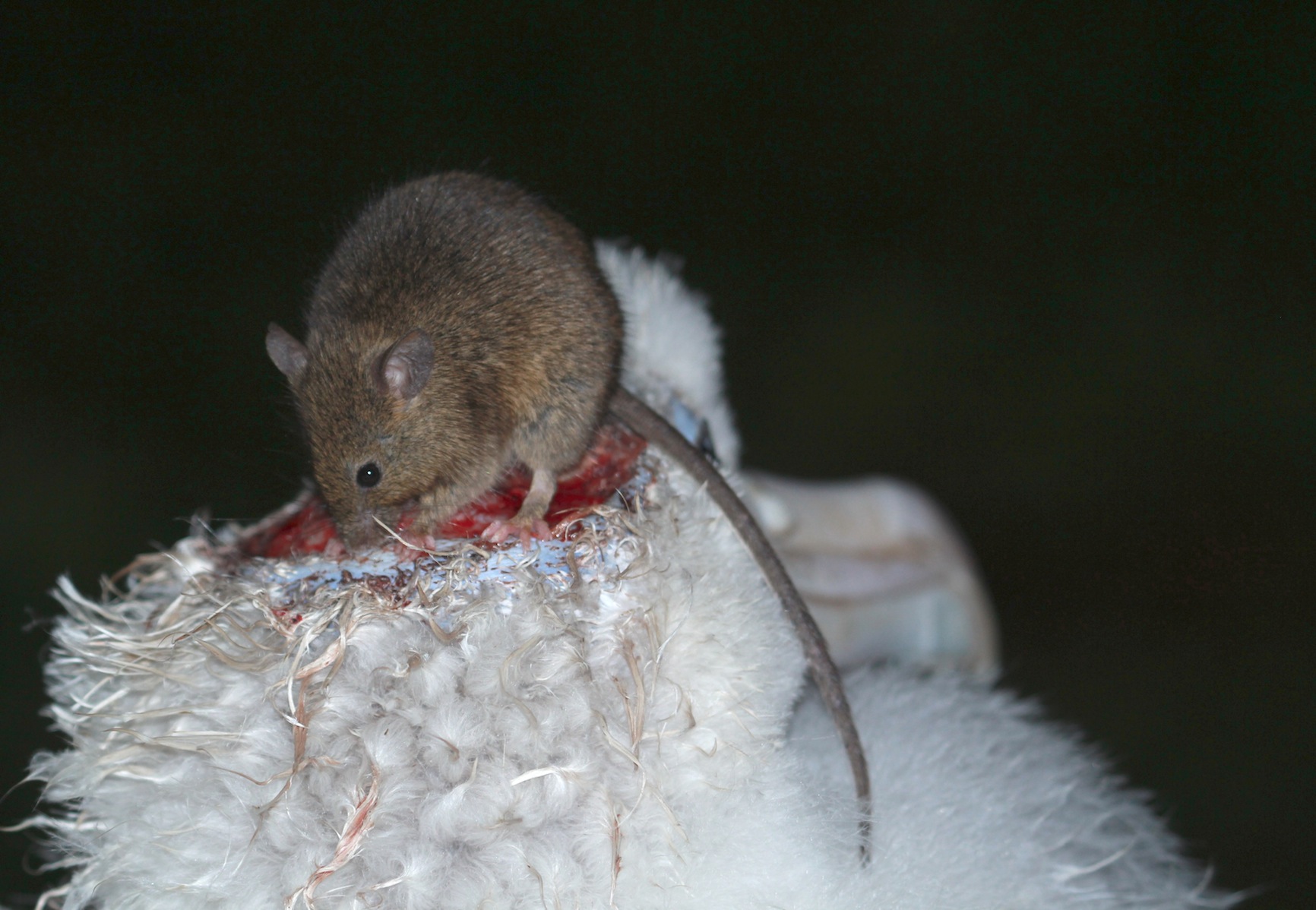
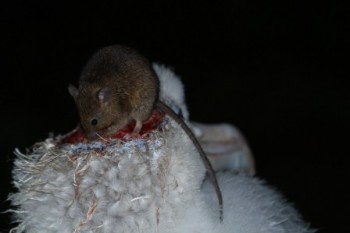
A Wandering Albatross chick is attacked by a House Mouse at night on Marion Island, photographs by Janine and Stefan Schoombie
South Africa is now considering making an eradication attempt on the island, as briefly mentioned in its Implementation Report (AC10 Inf 10) to ACAP’s meetings in Wellington, New Zealand this month.
Click here to read an earlier ALN story on mouse attacks on albatrosses on Marion Island.
With thanks to Ben Dilley, Peter Ryan and Janine and Stefan Schoombie for the photographs.
Selected Literature:
Angel, A. & Cooper, J. 2011. A review of the impacts of the House Mouse Mus musculus on sub-Antarctic Marion Island, Prince Edward Islands. Report to the Prince Edward Islands Management Committee, South African National Antarctic Programme.
Bester, M.N., Bloomer, J.P., Bartlett, P.A., Muller, D.D., van Rooyen, M. & Büchner, H. 2000. Final eradication of feral cats from sub-Antarctic Marion Island, southern Indian Ocean. South African Journal of Wildlife Research 30: 53-57.
Bester, M.N., Bloomer J.P., van Aarde, R.J., Erasmus, D.G., van Rensburg, P.J.J., Skinner, J.D., Howell, P.G. & Naude, T.W. 2002. A review of the successful eradication of feral cats from sub-Antarctic Marion Island, southern Indian Ocean. South African Journal of Wildlife Research 32: 65-73.
Chown, S.L. & Cooper, J. 1995. The Impact of Feral House Mice at Sub-Antarctic Marion Island and the Desirability of Eradication: Report on a Workshop held at the University of Pretoria, 16-17 February 1995. Pretoria: Directorate: Antarctica & Islands, Department of Environmental Affairs and Tourism. 18 pp.
Cerfonteyn, M. & Ryan, P.G. 2016. Have burrowing petrels recovered on Marion Island two decades after cats were eradicated? Evidence from sub-Antarctic skua prey remains. Antarctic Science 28: 51-57.
Dilley, B.J., Schoombie, S., Schoombie, J. & Ryan, P.G. 2016. ‘Scalping’ of albatross fledglings by introduced mice spreads rapidly at Marion Island. Antarctic Science 28: 73-80.
Dilley, B.J., Schramm, M. & Ryan, P.G. 2016. Modest increases in densities of burrow-nesting petrels following the removal of cats Felis catus from Marion Island. Polar Biology 40: 25-637.
Dilley, B.J., Schoombie, S., Stevens, K., Davies, D., Perold, V., Osborne, A., Schoombie, J., Brink, C.W., Carpenter-Kling, T. & Ryan, P.G. submitted ms. Mouse predation affects breeding success of burrow-nesting petrels at sub-Antarctic Marion Island.
Jones, M.G.W. & Ryan, P.G. 2010. Evidence of mouse attacks on albatross chicks on sub-Antarctic Marion Island. Antarctic Science 22: 39-42.
Parkes, J. 2016. Eradication of House Mice Mus musculus from Marion Island: a review of feasibility, constraints and risks. BirdLife South Africa Occasional Report Series No. 1. Johannesburg: BirdLife South Africa.
Schoombie, S., Crawford, R.J.M., Makhado, A.B., Dyer, B.M. & Ryan, P.G. 2016. Recent population trends of sooty and light-mantled albatrosses breeding on Marion Island. African Journal of Marine Science 38: 119-127.
John Cooper, ACAP Information Officer, 01 September 2017, revised 06 September 2017

 English
English  Français
Français  Español
Español